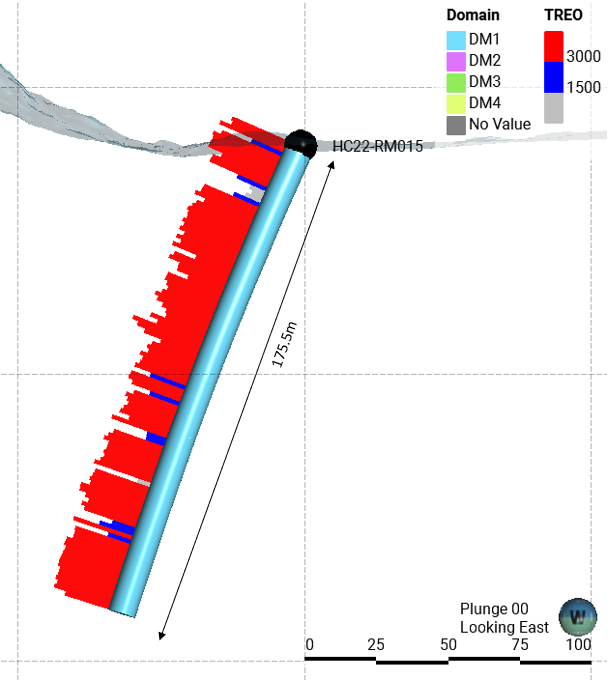The 600 samples collected from six RC holes at the Halleck Creek Rare Earths project in Wyoming were assayed, and the results have been provided by American Rare Earths.

Drill hole HC22-RM015. Image Credit: American Rare Earths
Highlights:
- Assays show unprecedented depths of 175.5 m for rare earth mineralization
- Depth of mineralization is 75.5% deeper than the original exploration target
- 27% of rare earths includes highly valuable magnetic rare earth elements
- Deposit remains open and with significant upside potential
- Major intercepts include:
- HC22- RM015 averages 4,303 ppm over 169.5 m
- HC22- RM022 averages 6,948 ppm over 37.5 m
- HC22-RM007 averages 3,966 ppm TREO over 150 m, over the complete length of the hole
The Red Mountain project area of the Halleck Mining district currently has complete assay data for 15 holes and partial assays for three (3) further holes.
The remaining assay outcomes for HC22-RM015 have been delivered to the company since the last release. These demonstrate the presence of enhanced rare earth mineralization along a distance of 169.5 m (487 ft) to a depth of 175.5 m (576 ft).
This is a depth that is 75.5% deeper than the 100 m that were sunk during the first drill campaign. Also based on a depth of 100 m was the exploration objective of 1.01 to 1.27 billion tons that was declared to the market on September 1st, 2022. Mineralization is still active at depth.
With an average total rare earth oxide (TREO) value of 3,996 ppm from the surface over the whole 150 m length of the hole, drill hole HC22-RM007 demonstrated excellent findings. Similarly, drill hole HC22-RM022 has a 37.5 m interval with an average TREO grade of 6,948 ppm.
The company is expecting the findings for 20 holes in the Overton Mountain project/ area and three more holes in the Red Mountain project area. The study was carried out by ALS laboratories in Vancouver, British Columbia.
Chris Gibbs, Chief Executive Officer and Managing Director, expressed his delight with the latest assay results.
These are outstanding results and we have consistently seen mineralization from surface to depths of 150 m. It is extremely encouraging to see mineralization now extend to at least 175.5 m. This is a 75.5% increase in depth from the maiden drill campaign and well exceeds the basis of the original exploration target of 100 m.
Chris Gibbs, Chief Executive Officer and Managing Director, American Rare Earths
He continued, “We are encouraged about the prospect of a significant rare earth structure at depth and are looking forward to conducting further drilling to determine how deep the deposit is. However, our priority is to establish a significant JORC resource, and at depths of 175.5 meters we already see the basis for a large scale, long life open pit mine on the magnitude of the major copper/gold porphyry deposits, so often seen in the Western USA.”
“Let’s keep in mind, these recent assay results are from the Red Mountain area, which is only one of seven zones we have identified in this massive rare earth district. We are eagerly anticipating the remaining drill assay results, including assays for the Overton Mountain zone which was also drilled during this most recent campaign,” Gibbs concluded.
Assay Results
An average TREO of 3,603 ppm was found in preliminary assay results from 15 RC holes in the Red Mountain project area. At Red Mountain, magnetic rare earth oxides (MREO) continue to make up around 27% of the rare earths, including the coveted Neodymium and Praseodymium.
Between October and December 2022, 18 RC holes were drilled in the Red Mountain project area and 20 more holes were made in the Overton Mountain project area.
The assay findings show that the Red Mountain Pluton’s (RMP) clinopyroxene quartz monzonite (CQM) and fayalite monzonite (FM) rocks consistently contain rare earth mineralization.
The main component of drill hole HC22-RM015, which was drilled to a depth of 175.5 m (576 feet), was CQM. The final sample from drill hole HC22-RM015 has a TREO value of 3,665 ppm, as previously announced.
The company has acquired all assays for drill hole HC22-RM015 since the last release. The average TREO value for this hole across a 169.5-m period is 4,303 ppm (487 feet).
Thorium and uranium’s penalty elements continue to have very low average values.